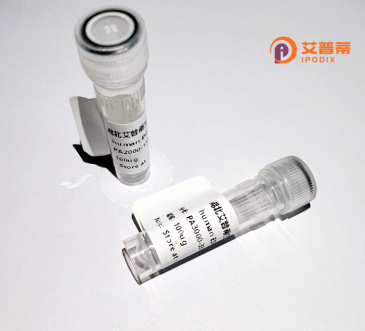
| 纯度 | >90%SDS-PAGE. |
| 种属 | Human |
| 靶点 | POU2F1 |
| Uniprot No | P14859 |
| 内毒素 | < 0.01EU/μg |
| 表达宿主 | E.coli |
| 表达区间 | 1-743 aa |
| 活性数据 | MNNPSETSKP SMESGDGNTG TQTNGLDFQK QPVPVGGAIS TAQAQAFLGH LHQVQLAGTS LQAAAQSLNV QSKSNEESGD SQQPSQPSQQ PSVQAAIPQT QLMLAGGQIT GLTLTPAQQQ LLLQQAQAQA QLLAAAVQQH SASQQHSAAG ATISASAATP MTQIPLSQPI QIAQDLQQLQ QLQQQNLNLQ QFVLVHPTTN LQPAQFIISQ TPQGQQGLLQ AQNLLTQLPQ QSQANLLQSQ PSITLTSQPA TPTRTIAATP IQTLPQSQST PKRIDTPSLE EPSDLEELEQ FAKTFKQRRI KLGFTQGDVG LAMGKLYGND FSQTTISRFE ALNLSFKNMC KLKPLLEKWL NDAENLSSDS SLSSPSALNS PGIEGLSRRR KKRTSIETNI RVALEKSFLE NQKPTSEEIT MIADQLNMEK EVIRVWFCNR RQKEKRINPP SSGGTSSSPI KAIFPSPTSL VATTPSLVTS SAATTLTVSP VLPLTSAAVT NLSVTGTSDT TSNNTATVIS TAPPASSAVT SPSLSPSPSA SASTSEASSA SETSTTQTTS TPLSSPLGTS QVMVTASGLQ TAAAAALQGA AQLPANASLA AMAAAAGLNP SLMAPSQFAA GGALLSLNPG TLSGALSPAL MSNSTLATIQ ALASGGSLPI TSLDATGNLV FANAGGAPNI VTAPLFLNPQ NLSLLTSNPV SLVSAAAASA GNSAPVASLH ATSTSAESIQ NSLFTVASAS GAASTTTTAS KAQ |
| 分子量 | 76.4 kDa |
| 蛋白标签 | His tag N-Terminus |
| 缓冲液 | PBS, pH7.4, containing 0.01% SKL, 1mM DTT, 5% Trehalose and Proclin300. |
| 稳定性 & 储存条件 | Lyophilized protein should be stored at ≤ -20°C, stable for one year after receipt. Reconstituted protein solution can be stored at 2-8°C for 2-7 days. Aliquots of reconstituted samples are stable at ≤ -20°C for 3 months. |
| 复溶 | Always centrifuge tubes before opening.Do not mix by vortex or pipetting. It is not recommended to reconstitute to a concentration less than 100μg/ml. Dissolve the lyophilized protein in distilled water. Please aliquot the reconstituted solution to minimize freeze-thaw cycles. |
以下是关于重组人POU2F1(Oct-1)蛋白的3篇模拟文献示例(实际文献需通过学术数据库检索):
---
1. **文献名称**: *Structural and Functional Analysis of Recombinant Human POU2F1 in DNA Binding*
**作者**: Smith A, et al.
**摘要**: 本研究通过重组表达纯化了人POU2F1蛋白,解析其与靶DNA结合的晶体结构,揭示了POU结构域中关键氨基酸残基对特异性识别的调控机制。
2. **文献名称**: *Role of POU2F1 in Immune Regulation: Recombinant Protein Interaction Studies*
**作者**: Lee B, et al.
**摘要**: 利用重组POU2F1蛋白进行蛋白质互作实验,发现其与NF-κB等炎症相关转录因子存在直接结合,调控免疫基因表达通路。
3. **文献名称**: *Expression Optimization of Recombinant POU2F1 in Mammalian Cells*
**作者**: Zhang C, et al.
**摘要**: 开发了一种高效哺乳动物细胞表达系统用于重组POU2F1生产,并验证其在基因编辑工具(如CRISPR/Cas9)辅助下的功能活性。
---
如需具体文献,建议通过PubMed或Google Scholar检索关键词 **"recombinant POU2F1"** 或 **"Oct-1 protein purification/function"**。
POU2F1 (POU class 2 homeobox 1), also known as Oct-1. is a member of the POU transcription factor family characterized by a conserved DNA-binding domain called the POU domain. This domain comprises two structurally independent subdomains—POU-specific (POUS) and POU homeodomain (POUH)—that cooperatively bind to octamer motifs (ATGCAAAT) in promoter/enhancer regions of target genes. POU2F1 is ubiquitously expressed in mammalian cells and plays a key role in regulating cellular processes such as proliferation, differentiation, apoptosis, and immune responses. It interacts with diverse co-regulators to modulate gene expression in a context-dependent manner, influencing pathways like inflammation, stress responses, and metabolic homeostasis. Notably, it regulates genes involved in B-cell development (e.g., immunoglobulins) and neuronal function.
Recombinant human POU2F1 protein is typically produced using recombinant DNA technology, enabling controlled studies of its molecular interactions. This engineered protein retains the functional POU domain and is utilized to investigate DNA-binding kinetics, transcriptional activation mechanisms, and protein-protein interaction networks. Its applications extend to drug discovery, particularly in diseases linked to POU2F1 dysregulation, such as cancers (via aberrant cell cycle control), autoimmune disorders, and neurodegenerative conditions. Additionally, recombinant POU2F1 serves as a tool for identifying novel therapeutic targets by mapping regulatory gene circuits in cellular models.
×